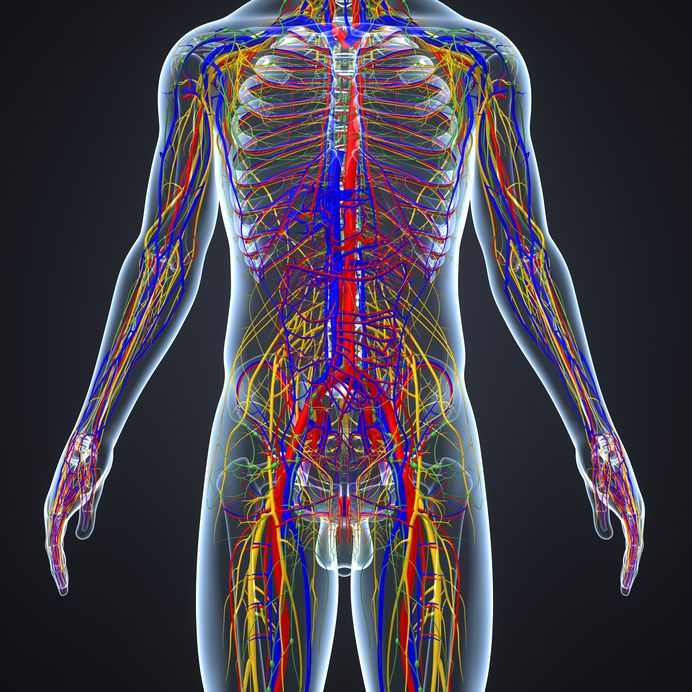The lymphatic system is tied to the optimal functioning of almost every aspect of the human body. It plays a role in injury and muscle soreness. It has a function for tissue regeneration, mental concentration, fluid regulation and warrants significant attention in the cancer population.
Knowing how this system functions and the implications for exercise will benefit all of your clients even if they have no direct interest in lymphatics.
Understanding The Lymphatic System
The lymphatic system is a complex pathway made up primarily of lymph vessels and lymph nodes. Lymph is a colorless fluid, essentially the waste disposal system of our tissues; and the lymph nodes are the body’s battlefields where most infections are fought.
The lymphatic system works to maintain healthy immunity, to drain stagnant fluids, regenerate tissues and detoxify the body by filtering out foreign substances. Any significant impairment in the lymphatic pathways can affect one’s ability to concentrate. Individuals suffering from this seem disorientated and tired and experience a feeling of general malaise without knowing why.
Knowledge of the importance of the lymph system may be of special interest to athletes and our clientele who may regularly experience muscle soreness or sustain the occasional injury. When tendons or ligaments have been damaged, fluid collects in small spaces surrounding the soft tissue; such pooling is referred to as swelling or edema.
While this is part of the natural healing process, as the body works to bring nutrient-rich fluid to the injured tissue for repair, recovery time can be decreased dramatically. The quicker the old, stagnant fluid moves out and tissues can receive fresh nourishment for regeneration, the sooner healing can occur.
Exercise and Fluid Regulation
The primary role of the lymphatic system during exercise is to assist in the regulation of tissue volume and pressure by carrying excess fluid and plasma back to the cardiovascular system. The heart, arteries, and veins could not operate without the lymphatic system, since the only means of returning fluids and plasma proteins back to the blood (approximately 2-3 liters every 24 hours) are via the lymphatic vessels.
During steady-state exercise, the flow of lymphatic fluid is two or three times higher than in a resting state. The National Institute for Health and Care Excellence (NICE) has made recommendations about exercise and lymphedema after breast cancer.
While there is no indication to date that exercise causes or worsens lymphedema in the otherwise healthy population, lymphatic system functioning can be impaired in a third to half of all breast cancer survivors.
Cancer and Its After-effects
Lymphedema is caused by the removal of axillary lymph nodes during breast cancer surgery, or by damage to those nodes or other lymphatic vessels during radiation treatment. Excess fluid collects in areas where lymph vessels/nodes are no longer present to help shuttle it to other body parts.
Although lymphedema symptoms vary among individuals, they typically include swelling and pain in the arm, chest, and breast area. It may also induce a feeling of heaviness and difficulty with fine motor skills required in daily life.
A 2009 study done at Lund University in Sweden in Physiotherapy Theory and Practice found that when women with breast cancer engaged in a regular program of light free weights as well as walking and water aerobics, they experienced relief from their symptoms.
Routine lifting of one-pound weights helped with muscle tone, arm strength, and bone density. Data from a 2005 study was published in the journal Lymphology. A small group of women with lymphedema learned to combine the practice of deep breathing with arm exercises, performed for 10 minutes every morning and evening.
At the end of one month, participants reported a decrease in arm swelling. In addition, their lymphedema symptoms were much milder than before engaging in regular exercise. Some of the women said that their arms felt better for a full month after the study concluded.
In 2009, a research project was undertaken with the examination of 141 people with breast cancer and subsequent lymphedema. Each of these participants had taken part in an exercise program. Half of the subjects received instructions about not overusing their arms; the other half engaged in progressive weight lifting.
All of the women in the study had lost one breast, had relatively healthy body weight, and had been finished with all therapy for at least one year. Certified lymphedema therapists monitored the women’s arms, and fitness professionals taught 90-minute classes twice a week. Results were later published in the New England Journal of Medicine. Researchers were surprised to find that the group assigned to weight lifting had significantly fewer lymphedema symptoms than the women who protected their arms.
Those who lifted weights, not surprisingly, also cultivated more strength. Gentle weight lifting can raise a client’s self-esteem, a vital step in the cancer recovery process, while also providing a sense of mastery over one’s body.
Initiating a Client’s Recovery Journey
If your client has not exercised in quite some time, either out of habit or the debilitating side effects of chemotherapy, discuss the importance of engaging in some aspect of exercise every day. Just as you do with her one-on-one strength training, anything done on her own should start gently and build up slowly.
Encourage her to think of ways she can build it into her daily routine. It may be as simple as including a daily walk with the family, a friend or a dog. Other options include Pilates and yoga classes, swimming, water aerobics or cycling.
Deep breathing helps by changing the pressure in the abdomen and chest. This encourages lymph to flow back into the blood system. Prior to embarking upon deep breathing exercises, position the client in a way that helps the lymph to drain properly and naturally. Show the client how to sit with her arm raised to a comfortable level, either on a cushion or a pillow, but not exceeding shoulder height.
Exercise Suggestions For Lymphedema
Instead of viewing a post-cancer client as having limitations, capitalize on all of the exercises she is capable of performing, and the multitude of ways they can improve her overall state of wellness.
Neck exercises
- Tilting – guide client to tilt head towards one shoulder, hold for 3 seconds, return to the center and repeat on the other side.
- Reminder: Keep shoulders still throughout exercise.
- Turning – turn head to look over one shoulder and hold for 3 seconds; return to facing forward and repeat the movement over the other shoulder.
- Reminder: Turn the head only, not the body.
- Chin to chest – bend neck down as far as comfort tolerates, chin to chest; hold for 2 seconds and then slowly bring head back up to neutral alignment.
Shoulder exercises
- Shrug by first relaxing the shoulders, then bringing them up toward the earlobes before allowing them to drop back down.
- Shoulder rolls – alternately rotate shoulders forward and backward.
Arm exercises
- Seated comfortably in a chair, place hands on knees, then shoulders, and progress to reaching fully extended toward the ceiling. Reverse the process.
- Pass a medicine ball around the waist, first in one direction and then the other.
The Detoxifying Bounce
An excellent way to purify the lymphatic system is through the practice of rebounding. While considered a relatively low impact movement, rebounding involves jumping on a trampoline. Such action promotes the flow of lymph through the body and is believed to increase the drainage of toxins from organs and muscle tissue.
Rebounding is a fun and safe way to detoxify the body’s lymphatic drains. If a mini trampoline is not yet part of your gym’s equipment collection, have the client jump on a stack of mats, reminding her to land each time with soft knees.
The Nutrition Component
Consuming a diet of anti-inflammatory foods, specifically raw fruits, and vegetables, helps hydrate the body and promote an alkaline environment. Since germs cannot flourish amid higher pH, the consumption of these foods expedites the removal of pathogens that may stagnate in lymph fluid.
Some foods that best detoxify the lymphatic system are red fruits and vegetables: pomegranates, raspberries, cherries, beets, and cranberries.
Understanding the intricacies of the human body is the cornerstone of our careers. Recognizing the importance of the lymphatic system will enable you to better serve a varied clientele, from dedicated athletes to those recovering from the aftereffects of breast cancer. There is always something positive we can offer our gym members; the better informed we remain, the better trainers we become.
_________________________________________
Article References
https://pdfs.semanticscholar.org/b639/33b46c2652aea354006704ad504a361b9d39.pdf
https://www.cancerresearchuk.org/about-cancer/coping/physically/lymphoedema-and-cancer/treating/exercise
https://patienteducation.osumc.edu/Documents/lymph-exercises-lower.pdf
https://www.verywellhealth.com/how-lifting-weights-may-help-lymphedema-430195



